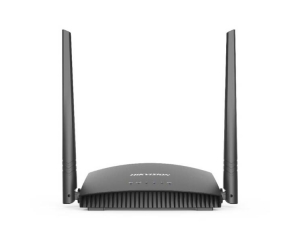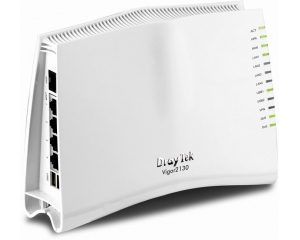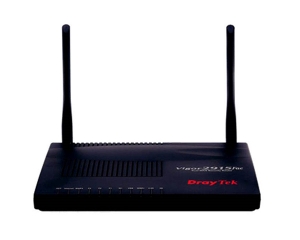
Router Wifi thông minh chuẩn N tốc độ 300Mbps HIKVISION DS-3WR3N

FTTH Router-Router cáp quang DrayTek Vigor2130

Firewall, Load Balancing DrayTek Vigor300B

Fiber Wireless VPN Router Draytek Vigor2915Fac


Switch CISCO SF350-24P-K9-EU 24-port 10/100 PoE+ Managed
24-port 10/100 PoE+ Managed Switch CISCO SF350-24P-K9-EU
- 24 ports 10/100 PoE+ with 185W power budget + 2 Gigabit copper/SFP combo + 2 SFP ports.
- Performance: Switching capacity 12.8 Gbps, Forwarding rate 9.52 mpps wire-speed performance.
- Layer 2: Port grouping up to 8 groups, up to 8 ports per group with 16 candidate ports for each (dynamic) 802.3ad link aggregation.
- Layer 3: IPv4 routing Wirespeed routing of IPv4 packets up to 1K static routes and up to 128 IP interfaces, Classless Interdomain Routing (CIDR) Support for CIDR.
- PoE: Power Dedicated to PoE: 185 W, Number of Ports That Support PoE: 24.
- QoS (Quality of Service): Priority levels 8 hardware queues, Scheduling Strict priority and weighted round-robin (WRR) Queue assignment based on DSCP and class of service (802.1p/CoS).
24-port 10/100 PoE+ Managed Switch CISCO SF350-24P-K9-EU
- 24 ports 10/100 PoE+ with 185W power budget + 2 Gigabit copper/SFP combo + 2 SFP ports.
- Performance: Switching capacity 12.8 Gbps, Forwarding rate 9.52 mpps wire-speed performance.
- Layer 2: Port grouping up to 8 groups, up to 8 ports per group with 16 candidate ports for each (dynamic) 802.3ad link aggregation.
- Layer 3: IPv4 routing Wirespeed routing of IPv4 packets up to 1K static routes and up to 128 IP interfaces, Classless Interdomain Routing (CIDR) Support for CIDR.
- PoE: Power Dedicated to PoE: 185 W, Number of Ports That Support PoE: 24.
- QoS (Quality of Service): Priority levels 8 hardware queues, Scheduling Strict priority and weighted round-robin (WRR) Queue assignment based on DSCP and class of service (802.1p/CoS).
Đặc tính kỹ thuật
| Model | SF350-24P-K9-EU |
| Performance | |
| Switching capacity and forwarding rate | Capacity in Millions of Packets per Second (mpps) (64-byte packets): 9.52 |
| All switches are wire speed and nonblocking | Switching Capacity in Gigabits per Second (Gbps): 12.8 |
| Jumbo frames | Frame sizes up to 9K (9216) bytes supported on 10/100 and Gigabit interfaces |
| MAC table | Up to 16K (16384) MAC addresses |
| USB slot | For file-management purposes |
| Layer 2 Switching | |
| Spanning Tree Protocol | Standard 802.1d Spanning Tree support Fast convergence using 802.1w (Rapid Spanning Tree [RSTP]), enabled by default 8 instances are supported Multiple Spanning Tree instances using 802.1s (MSTP) |
| Port grouping | Support for IEEE 802.3ad Link Aggregation Control Protocol (LACP): Up to 8 groups, Up to 8 ports per group with 16 candidate ports for each (dynamic) 802.3ad link aggregation |
| VLAN | Support for up to 4096 VLANs simultaneously Port-based and 802.1Q tag-based VLANs MAC-based VLAN Management VLAN Private VLAN Edge (PVE), also known as protected ports, with multiple uplinks Guest VLAN Unauthenticated VLAN Dynamic VLAN assignment via RADIUS server along with 802.1x client authentication CPE VLAN |
| Voice VLAN | Voice traffic is automatically assigned to a voice-specific VLAN and treated with appropriate levels of QoS Auto voice capabilities deliver networkwide zero-touch deployment of voice endpoints and call control devices |
| Multicast TV VLAN | Multicast TV VLAN allows the single multicast VLAN to be shared in the network while subscribers remain in separate VLANs (also known as MVR) |
| Q-in-Q VLAN | VLANs transparently cross a service provider network while isolating traffic among customers |
| Other | GVRP/GARP, UDLD, DHCP, IGMP, IGMP Querier, HQL booking, Loopback Detection, Jumbo frames |
| Layer 3 | |
| IPv4 routing | Wirespeed routing of IPv4 packets |
| Up to 1K static routes and up to 128 IP interfaces | |
| IPv6 routing | Wirespeed routing of IPv6 packets |
| Classless Interdomain Routing (CIDR) | Support for CIDR |
| Layer 3 Interface | Configuration of Layer 3 interface on physical port, LAG, VLAN interface, or loopback interface |
| DHCP relay at Layer 3 | Relay of DHCP traffic across IP domains |
| User Datagram Protocol (UDP) relay | Relay of broadcast information across Layer 3 domains for application discovery or relaying of bootP/DHCP packets |
| DHCP Server | Switch functions as an IPv4 DHCP server serving IP addresses for multiple DHCP pools/scopes Support for DHCP options |
| Security | |
| Secure Shell (SSH) Protocol | SSH is a secure replacement for Telnet traffic. SCP also uses SSH. SSH v1 and v2 are supported |
| Secure Sockets Layer (SSL) | SSL support: Encrypts all HTTPS traffic, allowing highly secure access to the browser-based management GUI in the switch |
| IEEE 802.1X (Authenticator role) | 802.1X: RADIUS authentication and accounting, MD5 hash; guest VLAN; unauthenticated VLAN, single/multiple host mode and single/multiple sessions Supports time-based 802.1X Dynamic VLAN assignment |
| Web-based authentication | Web based authentication provides network admission control through web browser to any host devices and operating systems |
| STP Bridge Protocol Data Unit (BPDU) Guard | A security mechanism to protect the network from invalid configurations. A port enabled for BPDU Guard is shut down if a BPDU message is received on that port |
| STP Root Guard | This prevents edge devices not in the network administrator’s control from becoming Spanning Tree Protocol root nodes |
| DHCP snooping | Filters out DHCP messages with unregistered IP addresses and/or from unexpected or untrusted interfaces. This prevents rogue devices from behaving as DHCP Servers |
| Support | IP Source Guard (IPSG), IP/MAC/Port Binding (IPMB), Secure Core Technology (SCT), Secure Sensitive Data (SSD), Layer 2 isolation Private VLAN Edge (PVE) with community VLAN |
| Port security | The ability to lock source MAC addresses to ports and limits the number of learned MAC addresses |
| RADIUS/TACACS+ | Supports RADIUS and TACACS authentication. Switch functions as a client |
| Storm control | Broadcast, multicast, and unknown unicast |
| RADIUS accounting | The RADIUS accounting functions allow data to be sent at the start and end of services, indicating the amount of resources (such as time, packets, bytes, and so on) used during the session |
| DoS prevention | Denial-Of-Service (DOS) attack prevention |
| ACLs | Support for up to 512 rules Drop or rate limit based on source and destination MAC, VLAN ID or IP address, protocol, port, Differentiated Services Code Point (DSCP)/IP precedence, TCP/UDP source and destination ports, 802.1p priority, Ethernet type, Internet Control Message Protocol (ICMP) packets, IGMP packets, TCP flag, time-based ACLs supported |
| Quality of Service | |
| Priority levels | 8 hardware queues |
| Scheduling | Strict priority and Weighted Round-Robin (WRR) Queue assignment based on DSCP and class of service (802.1p/CoS) |
| Class of service | Port based; 802.1p VLAN priority based; IPv4/v6 IP precedence/Type of Service (ToS)/DSCP based; Differentiated Services (DiffServ); classification and remarking ACLs, trusted QoS |
| Power over Ethernet (PoE) | |
| 802.3af PoE, 802.3at PoE+, and 60W PoE power are delivered over any of the RJ-45 ports within the listed power budgets | Switches support 802.3at PoE+, 802.3af, 60W PoE, and Cisco prestandard (older) PoE. Maximum power of 60W to any 10/100 or Gigabit Ethernet port for PoE+ supported devices and 15.4W for PoE supported devices, until the PoE budget for the switch is reached. The total power available for PoE per switch is as follows: Power Dedicated to PoE: 185W Number of Ports That Support PoE: 24 |
| PoE powered device and PoE passthrough | In addition to AC power, compact switch models can work as PoE powered devices and be powered by PoE switches connected to the uplink ports. The switch can also pass through the power to downstream PoE end devices if required Maximum of 60W can be drawn per uplink port if the peer PoE switch supports 60W PoE. When multiple uplink ports are connected to PoE switches, the power drawn from these ports is combined When AC power is connected and functioning properly, it will have priority over the PoE powered device function. The PoE powered device function will then act as a backup power source to the AC power. The PoE powered device function will be the primary power source for the switch if AC power is not connected |
| Green Power (Mode) | Energy Detect |
| System Power Consumption | 110V=10.6W 220V=10.9W |
| Power Consumption (with PoE) | 110V=240W 220V=230W |
| Heat Dissipation (BTU/hr) | 684.1 |
| Total System Ports | 24 Fast Ethernet + 4 Gigabit Ethernet |
| RJ-45 Ports | 24 Fast Ethernet |
| Combo Ports (RJ‑45 + SFP) | 2 Gigabit Ethernet combo + 2 SFP |
| Buttons | Reset button |
| Cabling type | Unshielded Twisted Pair (UTP) Category 5 or better for 10BASE-T/100BASE-TX; UTP Category 5 Ethernet or better for 1000BASE-T |
| LEDs | System, Link/Act, PoE, Speed, LED power saving option |
| Flash | 256 MB |
| CPU memory | 512 MB |
| Packet buffer | All numbers are aggregate across all ports as the buffers are dynamically shared: 12 Mb |
| Environmental | |
| Dimensions | 440 x 44 x 257 mm |
| Weight | 4.08 kg |
- Bảo hành: 12 tháng.





CÔNG TY TNHH CÔNG NGHỆ VIỄN THÔNG GIA PHẠM
1252/12 Đường Tân Phước, Khu Phố Tân Phước, Phường Tân Đông Hiệp, TP Hồ Chí Minh
Văn Phòng: Số 025K Đường DT747B, Tổ 5, KP 7, Uyên Hưng, P Tân Uyên, TP HCM
Showroom : 202 - Phạm Ngọc Thạch - KP Hiệp Thành - TP Thủ Dầu Một.
Liên hệ : 0274.3616062 - 0274.3616063
Kinh doanh: 0937 87 63 70 Ms Hân - 0908 031 721 Ms Thúy Kế toán: 0917 13 91 96 Ms Linh
Mã Số Thuế: 3702984737
Hotline: 0911 14 24 54 Mr Sang | 0933 488560 Mr Tây | 0917 139196 Ms Linh
Email: support@maytinhgiapham.com| Website: https://www.maytinhgiapham.com
© 2021 MÁY TÍNH GIA PHẠM | CÔNG TY TNHH CÔNG NGHỆ VIỄN THÔNG GIA PHẠM.
Đang online: 129 | Tổng truy cập: 3909545





